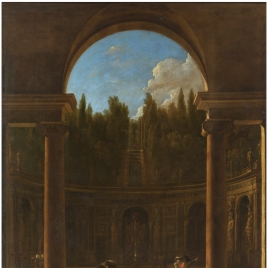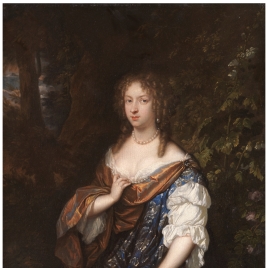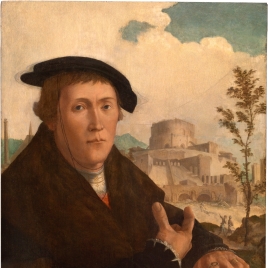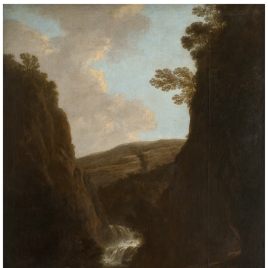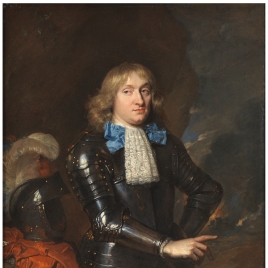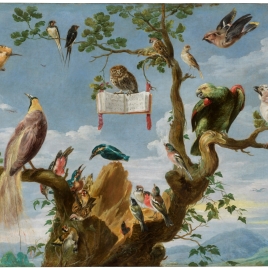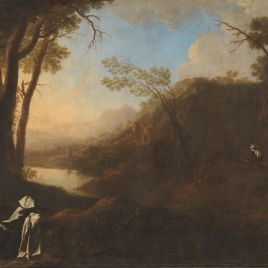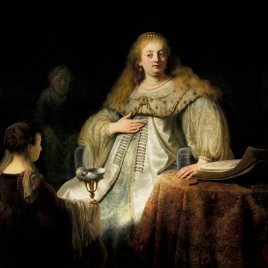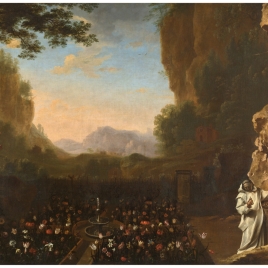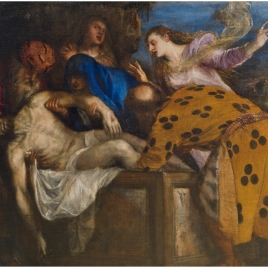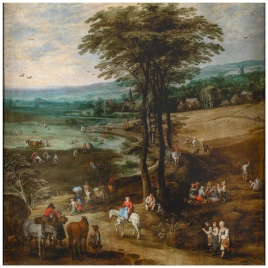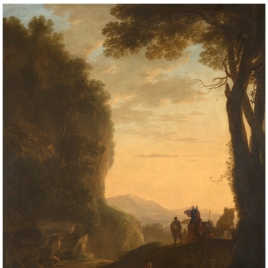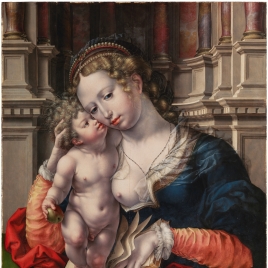Cargando ...
Explore the collection
Artist
Landscape with Saint Benedict of Nursia
Oil on canvas. 1634 - 1639
This painting entered the Museum`s holdings as Saint Francis in the Brambles by Jan Both. The scene is correctly classified in the catalogue of 1873. A decade later Valdivieso (1973) identifies it as the landscape listed in the Buen Retiro inventory of 1701 and proposes it be attributed to Herman van Swanevelt, albeit with the possible collaboration of Jan Both in the landscape. Luna (1984), Bargh
The Aldobrandini Garden at Frascati
Oil on canvas. XVII century
The earliest documentary reference to this painting appears in the 1772 inventory of the Palace of the Buen Retiro, in which the setting is attributed to Viviano Codazzi (1603/4-1672) and the figures to Aniello Falcone (1607-1656). However, this architectural view has traditionally been considered part of the set of landscapes -with hermits and bucolic scenes- commissioned in Rome to decorate the
Alida de Lange, Wife of Johan Rammelman
Oil on canvas. Ca. 1679
These two paintings were first shown in Amsterdam in 1858. On that occasion the sitters were identified as Lambert Witsen and his wife Sara Nuyts owing to the woman`s purported similarity to the portrait of the latter (Amsterdam Historisch Museum, inv. SA 989) dated 1684 and included thus by Jan de Baen (1633-1702) in his work, Portrait of the Regents of the Spinhuis in Amsterdam.Moes (1897-1905)
Oil on panel. Ca. 1540
Scorel, Jan van (Attributed to)
Although this panel is not documented, it has been attributed to Scorel since its attribution by Hoogewerff in 1923.The artist depicts the unknown humanist half-length in front of a landscape. Scorel’s time in Venice in 1520 acquainted him with the work of the artists working there, in particular Lorenzo Lotto.The latter had a major influence on his portraits, some of which reveal Scorel’s love of
Oil on panel. 1541
By far one the most popular themes in Marinus’ surviving work, Saint Jerome in his study has come down to us in several compositions. The preoccupation with this particular subject was a reaction to the early sixteenth-century concern with the depiction of the saint, who was venerated as one of the four fathers of the Western Church and held in high esteem as a scholar and the translator of the Bi
Landscape with Fishermen and Shepherds on a Riverbank
Oil on canvas. 1639 - 1641
The present painting entered the Museum as an original work by Jan Both. This attribution is maintained in subsequent catalogues and accepted by all authors. This landscape is an exception among those commissioned in Rome for the Palace of the Buen Retiro in that it is the only one that depicts a wild landscape. In addition, it does not extend into the distance; rather, the background is abruptly
Oil on canvas. Ca. 1679
These two paintings (P7607 and P7608) were first shown in Amsterdam in 1858. On that occasion the sitters were identified as Lambert Witsen and his wife Sara Nuyts owing to the woman`s purported similarity to the portrait of the latter (Amsterdam Historisch Museum, inv. SA 989) dated 1684 and included thus by Jan de Baen (1633-1702) in his work, Portrait of the Regents of the Spinhuis in Amsterdam
Oil on canvas. 1639 - 1641
Asselijn, Jan (Attributed to)
In the 1701 inventory it is not listed among the group of landscapes with hermits or with bucolic scenes but many entries earlier, together with View of the Waterfall at Tivoli, with Fishermen (P2068) which it matches in size and theme -and Landscape with Saint Mary of Cervelló, now attributed to Claude Lorrain (P3259), which would appear to indicate that they were hung in a different room,
Oil on canvas. 1629 - 1630
In the composition, an owl on a branch directs a chorus of fifteen other types of birds while holding a score between its feet. Such images of different species of birds perched on tree trunks, sometimes with musical scores, were known as Concerts of birds and were popularized by Flemish artists in the early decades of the 17th century, especially Frans Snyders. They were quite common at that time
Oil on canvas. 1634 - 1639
This painting entered the Museum as an original work by Jan Both, attribution that has been maintained in the catalogues until the present day. In 1973 Valdivieso identifies it as the picture listed in the 1701 inventory of the Palace of the Buen Retiro and retains the ascription to Jan Both, which is supported by Luna (1984) and Capitelli (2005). Burke (1976) refers to it without an attribution.B
Judith at the Banquet of Holofernes
Oil on canvas. 1634
Rembrandt (Rembrandt Harmensz. van Rijn)
In the past various authors have expressed their scepticism about the attribution of the painting to Rembrandt. However, the Rembrandt Research Project includes it in the Corpus of 1986 as an original work, and this is supported by the technical study conducted at the Museo del Prado that year. As for the signature, the unsteadiness of the stroke and, above all, the yellow colour make it dubious.
Landscape with a Carthusian (Saint Bruno?)
Oil on canvas. 1636 - 1638
The painting entered the Museum holdings as an original work by Jan Both. In 1959 Blunt identifies it as the landscape listed in the 1701 inventory of the Palace of the Buen Retiro and maintains the attribution to Both, as does Roethlisberger (1961). However, Waddingham (1960) ascribes it to Herman van Swanevelt, an attribution backed by Luna (1984) and officially adopted by the Museum in 1985. Th
Oil on canvas. 1572
Titian represented the Gospel account of the burial of Christ (Matthew 27: 57-61; Mark 15: 44-47; Luke 23: 50-54; John 19: 38-42) on several occasions. There is a notable difference between his first version (Paris, Louvre) of around 1526 which is clearly indebted to Raphael´s painting of that subject (Rome, Galleria Borghese), and his other versions painted between 1559 and 1572. The main differe
Oil on panel. 1518 - 1520
The Virgin and Child are placed on a hill in the centre of the foreground, isolated from the rest of the figures, as in the Berlin panel (Gemäldegalerie ). The dark forest here begins in the middle ground behind the Virgin, merging with the background landscape to one side of the main figure. The countryside to the right, with the motifs of the farm, the village in the middle ground and the c
River Landscape with Riders and a Tower
Oil on canvas. XVII century
Anonymous (Circle of: Both, Jan)
On entering the Museum this painting was inventoried as a product of the Sevillian school, though the 1876 catalogue lists it as a work executed in the style of Jan Both. Valdivieso (1973) considers it to be an eighteenth-century Italian work, while Barghahn (1986) identifies it as one of the landscapes in the Palace of the Buen Retiro inventory, though in fact neither the measurements nor the des
Oil on canvas. 1620 - 1622
Brueghel the Elder, Jan (Jan 'Velvet' Brueghel) ; Momper II, Joost de
Oil on canvas. 1620 - 1622
Brueghel the Elder, Jan (Jan 'Velvet' Brueghel) ; Momper II, Joost de
A broad view of the Flemish countryside, with diverse scenes of peasants carrying out their respective tasks. This is one of the finest examples of the collaboration between Jan Brueghel “the Elder”, who is thought to have painted the figures, and Joos de Momper, who made the landscape. The scene is formed by accumulating various planes that follow each other toward the back, in perspective. The e
The Baptism of Queen candace´s Eunuch
Oil on canvas. 1639 - 1641
This painting entered the museum as a work by Claude Lorrain, but in 1843, it appeared in the catalog as an original by Jan Both, an attribution that has been maintained in posterior catalogs and is accepted without argument by specialists.Drawn from Acts (VIII: 26-38), the subject is the conversion and baptism of Queen Candace of Ethiopia by the Apostle Philip the Eunuch, who did so while returni
Oil on panel. 1527 - 1530
Gossaert, Jan (Jean Gossart, also called Mabuse)
Mary sits in front of a Renaissance shrine. The figures look like sculptures, as was customary in Gossaert from 1508-1509 on. They reflect his study of ancient sculptures and the drawings he made during his trip to Rome in the company of his patron, Phillip de Bourgogne. Despite the plastic character of his Romanism, there are also echoes of Raphael in the pyramidal composition. Faithful to the Fl
Loading...


